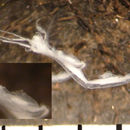en
names in breadcrumbs


Length: 7-12mm. Body smooth, cephalon of large males with very small anterior projection (angular fore-head). Antenna 1 a little longer than 1/3 body length; antenna 2 a little longer than antenna 1 peduncle, flagellym bi-articulate. Propodus of gnathopod 1 with 2 proximal grasping spines, grasping margin of dactylus serrate. Gnathopod 2 attached posterior to median of pereonite 2; propodus elongate with median poison tooth, concave palm and distal triangular projection; dactylus less than one-half length of propodus. Gills elliptical, usually bent forward. Pereopods 5 - 7 propodus without distinct grasping spines, palmar margin usually with numerous stout setae; grasping margin of dactylus serrate. Male abdomen with pair of appendages hooked distally.
Pan-tropical and wide-spread: Mediterranean; North Africa; Black Sea; Western Australia; Bay of Biscay; Japan; Caribbean; Brazil
Caprellid, “Ghost” or “Skeleton” shrimps, so called for their skeletal appearance. Amphipod crustaceans, easily distinguished by the elongate stick-like body form and reduction of the abdominal appendages. Head is generally fused with pereonite 1. Pereopods on first 2 segments (pereonites) are most flexible and called gnathopods; gnathopods 2 being the largest, used in defense, feeding and substrate attachment. In many species pereopods 3 and 4 may also be reduced or absent. Gills on pereonites 3 + 4, rarely on pereonite 2. Pereopods 5 - 7 much smaller than 1 + 2, used for clinging to the substratum. In females, brood plates (öostegites) develop on pereonites 3 + 4. Much remains to be learnt about their biology, ecology and in many cases changing distributions.
Surface to 80m depth. Attached to: Cystoseira, Sargassum, Bugula, algae, hydroid + bryozoan communities
Easily distinguished by distinct gill shape.
National Museum of Natural History, Washington DC: (NMNH) 305410-305411